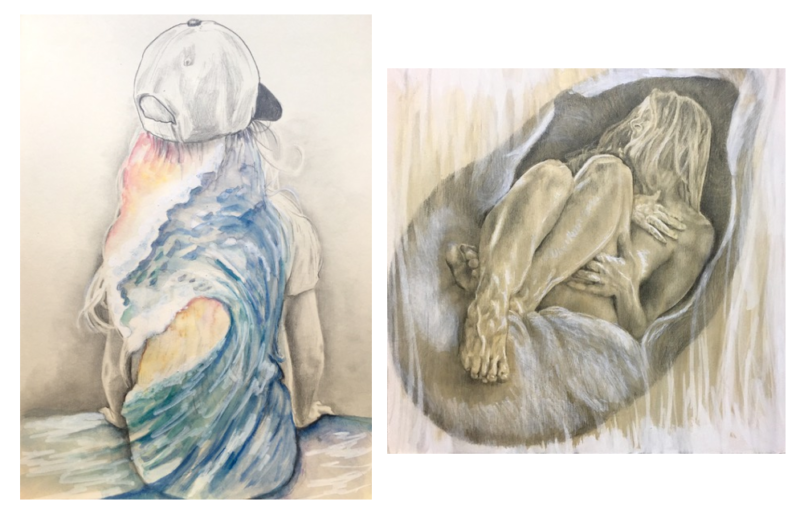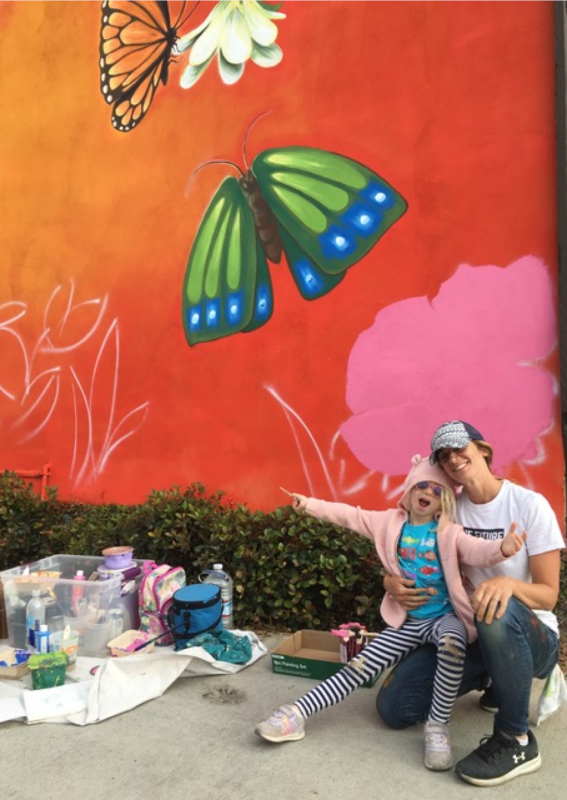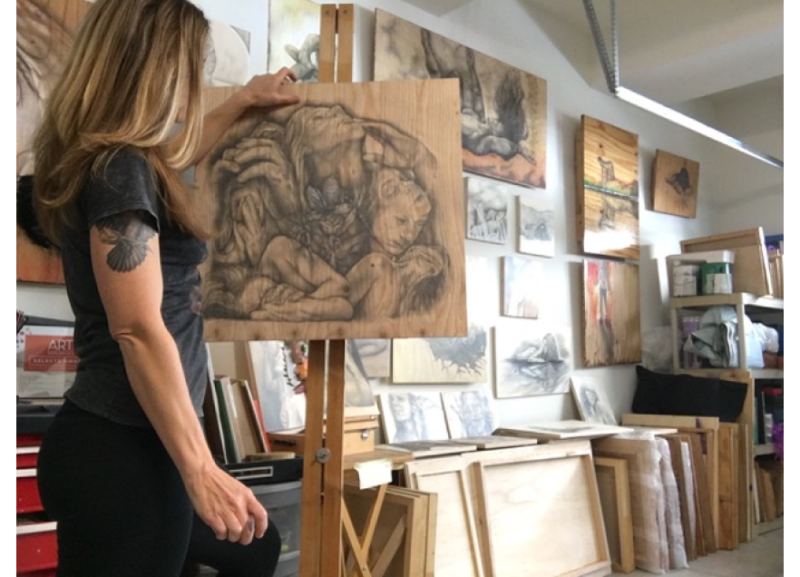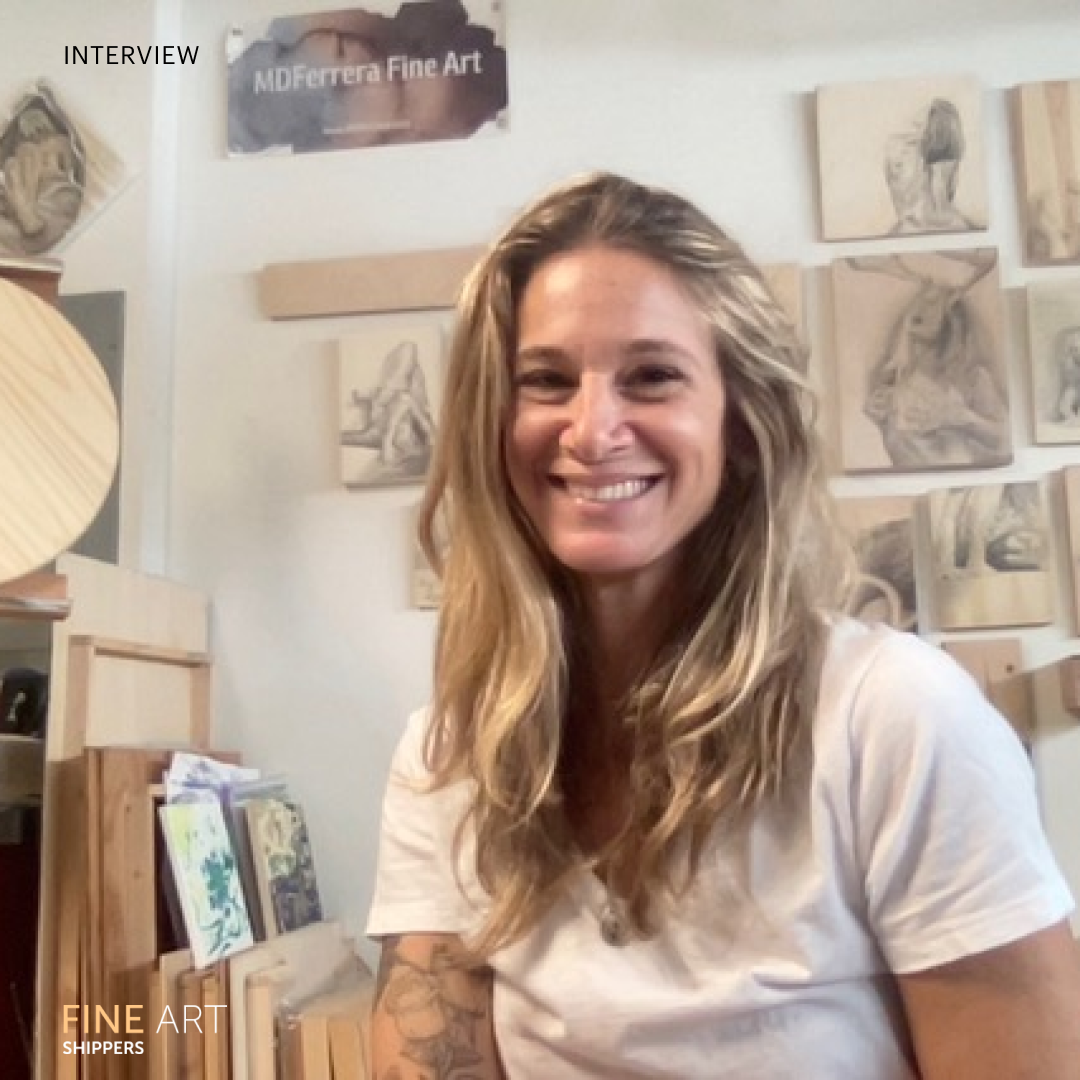California-based artist and muralist Michelle Lubin creates custom art, commissioned portraits, and murals. She believes in community spirit and collaboration in art and helps develop the local art scene in San Diego where she lives. In an interview with Fine Art Shippers, Michelle Lubin shared the memories of her father, who introduced her to art, her first steps in San Diego, and the healing power of drawing on wood.
Artist Talk: Michelle Lubin on the Healing Power of Art
How did your journey in the world of art begin? On your website, you mention the influence of your father, Richard Ferrera. Michelle Lubin: My father, despite being visually impaired, was a passionate visual artist. Being the youngest of four girls, I was following him everywhere, always eager to be part of whatever he was working on. It was only after he was gone that I truly understood how deeply our shared moments influenced me. With him, creativity wasn't just about art; it was music, interior design, and every possible form of expression. I miss him very much; I cherish his influence on my creative soul. Another significant impact was the San Diego art community. Could you elaborate on that? What exactly did you find in the city? I grew up in New Jersey but made the move to San Diego about thirteen years ago. At first, I didn't know anyone, and navigating the art world felt like feeling my way in the dark. There's no set playbook for artists like in teaching or law, for example. I initially tried building my career in Los Angeles, but it was frustrating, and I felt lost. My now-husband suggested San Diego, with its tight-knit and supportive community. And he was right. Unlike New York and LA, San Diego's art scene was collaborative, everyone was eager to help each other. This made it easy for me to fall in love with the city. The opportunities I got, one after the other, and the guidance from local galleries and collectives really helped me build my career.  Could you share some examples of the support you received as a newcomer in the San Diego community? Despite being naturally sensitive and anxious, a part of me always felt the need to take chances and step out of my comfort zone. So I made a point of attending art shows, observing, listening to names and conversations, trying to understand the environment. A turning point came when I joined the international collective named " RAW Natural Born Artists." They significantly boosted my exposure. Similarly, the team at Thumbprint gallery in La Jolla, specifically Johnny and Paul, played a pivotal role in my journey. Their enthusiasm was infectious. I’m extremely grateful to them for the warmth and the sense of community they offered when I felt alone. The support and the opportunities they provided are the memories I'll always cherish. As I understand, you now aim to give back to the community through your involvement in the Imperial Beach Arts Bureau (IBAB). What exactly does your work involve? The IB Arts Bureau is a local arts organization that offers resources and raises funds for public art projects. I connected with them shortly after moving to town in 2018. I began painting my own murals and soon realized I wanted not only to do my own work but also to support local art. I’m proud to say that in our small beach town, we have around thirty-five murals, which is a lot, and most of them are by female artists. Observing the drab appearance of my daughter's elementary school, I felt the urge to bring life and color to such spaces. We now assist in student-centric designs and murals on their campus. With two other IBAB members, we formed an art committee for organizing local exhibits. We've already curated two shows and are planning a third. The joy it brings me isn't just in showcasing diverse local art but in empowering other artists, giving them platforms and resources.
Could you share some examples of the support you received as a newcomer in the San Diego community? Despite being naturally sensitive and anxious, a part of me always felt the need to take chances and step out of my comfort zone. So I made a point of attending art shows, observing, listening to names and conversations, trying to understand the environment. A turning point came when I joined the international collective named " RAW Natural Born Artists." They significantly boosted my exposure. Similarly, the team at Thumbprint gallery in La Jolla, specifically Johnny and Paul, played a pivotal role in my journey. Their enthusiasm was infectious. I’m extremely grateful to them for the warmth and the sense of community they offered when I felt alone. The support and the opportunities they provided are the memories I'll always cherish. As I understand, you now aim to give back to the community through your involvement in the Imperial Beach Arts Bureau (IBAB). What exactly does your work involve? The IB Arts Bureau is a local arts organization that offers resources and raises funds for public art projects. I connected with them shortly after moving to town in 2018. I began painting my own murals and soon realized I wanted not only to do my own work but also to support local art. I’m proud to say that in our small beach town, we have around thirty-five murals, which is a lot, and most of them are by female artists. Observing the drab appearance of my daughter's elementary school, I felt the urge to bring life and color to such spaces. We now assist in student-centric designs and murals on their campus. With two other IBAB members, we formed an art committee for organizing local exhibits. We've already curated two shows and are planning a third. The joy it brings me isn't just in showcasing diverse local art but in empowering other artists, giving them platforms and resources.  Your art is very versatile, ranging from small drawings to paintings on wood and large murals. Could you tell me about your process? How do you switch between these creative modes? What influences your choice of what you want to work on? My every piece of art starts in my journals, which I carry everywhere. Often, it isn't sketches but writing that fills their pages. Writing, especially free writing, has always been my first love. In workshops, I encourage participants to freely jot down their thoughts, as it helps clear the mind and provides direction. As for the different creative modes, my favorite medium is drawing on wood; it’s a healing practice for me, connecting me to memories of my dad, who loved woodworking. Amidst the chaos of my thoughts, it always offers solace and clears the mind. Painting murals is a different, more physical process involving the whole body, where the joy comes from the interaction with the wall and the paint and the wide range of motion. What is the difference between the process of drawing a small pencil piece on wood and creating a large-scale mural? How much time does it take in each case? The time it takes depends on the size and idea of the artwork. For example, I recently completed a floral mural at my daughter's school in just a few hours. Some larger walls can take up to two weeks, especially when the weather comes into play. There's an addictive thrill to creating murals. I put on my headphones, set my music playing, and lose myself in the rhythm of the work—it's like dancing. It’s also an interactive experience; I often engage in conversations with passers-by. When I invite them to join in and contribute, they get really excited. In contrast, working on wood is introspective and solitary, requiring patience and focus. As a portrait painter, how do you connect with your subject to convey their personality? The more I know about the person I'm painting, the easier it is to capture and convey their personality. Most of the portraits I’m commissioned are gifts, and I usually ask clients to provide several photos showing the person in various situations. This helps me understand them better. It’s also helpful to hear stories and anecdotes about them. Creating a portrait based on just one photo would feel incomplete and devoid of depth and emotion.
Your art is very versatile, ranging from small drawings to paintings on wood and large murals. Could you tell me about your process? How do you switch between these creative modes? What influences your choice of what you want to work on? My every piece of art starts in my journals, which I carry everywhere. Often, it isn't sketches but writing that fills their pages. Writing, especially free writing, has always been my first love. In workshops, I encourage participants to freely jot down their thoughts, as it helps clear the mind and provides direction. As for the different creative modes, my favorite medium is drawing on wood; it’s a healing practice for me, connecting me to memories of my dad, who loved woodworking. Amidst the chaos of my thoughts, it always offers solace and clears the mind. Painting murals is a different, more physical process involving the whole body, where the joy comes from the interaction with the wall and the paint and the wide range of motion. What is the difference between the process of drawing a small pencil piece on wood and creating a large-scale mural? How much time does it take in each case? The time it takes depends on the size and idea of the artwork. For example, I recently completed a floral mural at my daughter's school in just a few hours. Some larger walls can take up to two weeks, especially when the weather comes into play. There's an addictive thrill to creating murals. I put on my headphones, set my music playing, and lose myself in the rhythm of the work—it's like dancing. It’s also an interactive experience; I often engage in conversations with passers-by. When I invite them to join in and contribute, they get really excited. In contrast, working on wood is introspective and solitary, requiring patience and focus. As a portrait painter, how do you connect with your subject to convey their personality? The more I know about the person I'm painting, the easier it is to capture and convey their personality. Most of the portraits I’m commissioned are gifts, and I usually ask clients to provide several photos showing the person in various situations. This helps me understand them better. It’s also helpful to hear stories and anecdotes about them. Creating a portrait based on just one photo would feel incomplete and devoid of depth and emotion.  Lastly, a personal question. Your daughter is growing up in such a creative environment. What is her relationship with art? Do you teach her painting and drawing? People often ask this question to me. Rather than teaching her, I prefer to give her tools and freedom. I believe children just need encouragement, support, and faith in their capabilities. Recently, she painted a large banana on her bedroom door. Even though I could have easily crafted something for her, I didn’t do it because it's her personal space. I enjoy watching her express herself and create a world where she feels content and fulfilled. This is something my father taught me by example and for which I’m very grateful to him. Interview by Inna Logunova Photo courtesy of Michelle Lubin
Lastly, a personal question. Your daughter is growing up in such a creative environment. What is her relationship with art? Do you teach her painting and drawing? People often ask this question to me. Rather than teaching her, I prefer to give her tools and freedom. I believe children just need encouragement, support, and faith in their capabilities. Recently, she painted a large banana on her bedroom door. Even though I could have easily crafted something for her, I didn’t do it because it's her personal space. I enjoy watching her express herself and create a world where she feels content and fulfilled. This is something my father taught me by example and for which I’m very grateful to him. Interview by Inna Logunova Photo courtesy of Michelle Lubin
